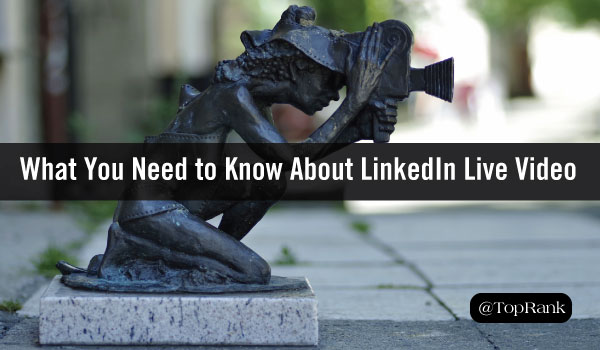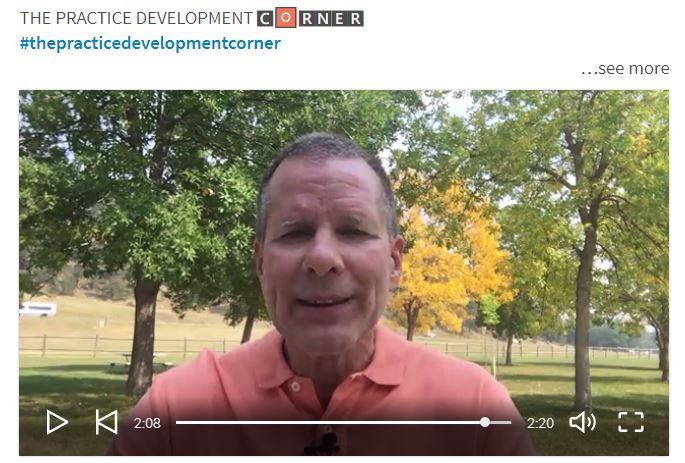
Video content is eating the internet. It started with video-specific platforms like YouTube and Vimeo. Then Twitter and Facebook added support for live and pre-recorded video. Now these insatiable moving pictures are becoming serious business: LinkedIn now supports native video.
What would compel a buttoned-down, professional networking site like LinkedIn to embrace video? Simply put, people—even businesspeople—want to watch. Fifty-nine percent of executives say that if text and video are available on the same topic, they’re more likely to choose video.
There’s no denying that marketers should embrace video content as a general rule. If your audience wants video, it’s wise for your brand to be the one supplying it. But why publish natively on LinkedIn?
Here are the upsides, downsides, and what-you-need-to-know-sides.
How to Create a LinkedIn Video
LinkedIn has been slowly rolling out its video capabilities, starting with a few influencers and expanding out from there. Most members who have the most recent version of the mobile app should have the capability now.
If your account has video enabled, you will see a camera icon available where you normally post to your feed. On mobile, you can create a video (not a live stream…yet) or upload from your photo gallery. On desktop, you can only upload a pre-recorded video. Nearly every common form of video file is supported.
To record a video, just tap the camera icon, give the app permission to access your camera, and go. To upload video, just navigate to the file you want to add and select it—there’s no learning curve there.

Your file must be at least three seconds long and no longer than 10 minutes, but LinkedIn suggests between 30 seconds and 5 minutes for better engagement. The maximum file size is five gigabytes, which should be plenty of space.
Your post will look…well, a lot like a post with an embedded video, just without the link out at the bottom:

Why Marketers Should Care about LinkedIn Video
You can already embed YouTube video in your LinkedIn feed posts, of course. But posting native video may get you more engagement. On Facebook, native videos typically get 10x more shares than embedded videos. If that trend holds for LinkedIn, you could be missing out on a substantial chunk of potential audience by linking to a YouTube video.
So native video matters—and for virtually all B2B marketers, LinkedIn matters. While Facebook videos can be dominated by memes and entertainment, the LinkedIn audience is specifically there for business. They’re browsing their feeds looking for something that can help advance their career, give them a competitive edge, or just do their jobs better. Useful, professional video content is likely to fare better on LinkedIn than on Twitter or Facebook.
The other reason to go native on LinkedIn video is LinkedIn’s analytical capability. Their demographic data is likely to be more useful to B2B marketers than Facebook’s data is. You can zero in on job function, job title, and seniority of the people who view your video. That data will help you adjust your strategy to hit and engage the right audience.
As native video is more widely adopted by its userbase, LinkedIn is likely to give it preferential treatment over embedded video. LinkedIn has already switched from a pure timeline feed to an algorithm-based feed. Just as Facebook currently gives pride of place to native videos, LinkedIn is likely to prioritize it in their feeds, too.
Downsides to LinkedIn Video
Since this is a new feature, there are some still some quirks to be ironed out, and a few features that are missing. These negatives won’t keep your video from being seen and appreciated, but they’re worth noting:
- No playback speed or picture quality settings. Users can’t customize the viewing experience the way they can on YouTube.
- It’s hard to link out. the URLs for a video-embedded post are unwieldy: https://www.linkedin.com/feed/update/urn:li:activity:6316276929771245568/, for example.
- The video isn’t embeddable on other sites. It’s definitely intended for consumption on LinkedIn.
- Only members can post, not companies.
- There’s no dedicated video tab, which can make video content hard to find. I’m willing to bet some kind of tab or filter is in the works, but we don’t have it yet.
What to Use LinkedIn Video For:
Given the limitations of the format, it’s best to think of video on LinkedIn as an add-on to your current marketing strategy. Use it to build your personal brand, or go behind-the-scenes at your company, or interview co-workers and executives.
Many users are already using the format to do quick tips, like this video from Viveka Von Rosen. That kind of informal, live-shot video is an easy way to get started.
There are a few people attempting to create series on the platform, too. Building an audience for a series could be tricky without a dedicated video tab, but Mike Morgan’s Humans of LinkedIn series is making a go of it. If more people start serializing their videos, LinkedIn is likely to add tools that support the practice.
LinkedIn to the Future
If you’re marketing to a B2B audience, native video on LinkedIn is well worth a try. Instead of linking out to YouTube, upload the video natively to LinkedIn and keep an eye on how it performs. Make sure to include keywords and relevant hashtags in the post so your video is easier to find, keep an eye on your analytics, and let the data guide your next steps.
Need more help? Check out these easy ways to get started with video content marketing.
Disclosure: LinkedIn Marketing is a TopRank Marketing client.


